
HALIFAX, NS / ACCESSWIRE / November 26, 2020 / Namibia Critical Metals Inc. ("Namibia Critical Metals" or the "Company" or "NMI") (TSXV:NMI) is pleased to provide an update on progress on the Lofdal Heavy Rare Earth Project in northern Namibia "Lofdal" or "the project"). Lofdal is a joint venture between the Company and Japan Oil, Gas and Metals National Corporation ("JOGMEC") which is operating under a Term 1 budget of CD$4,100,000 (Company press release September 21, 2020). Highlights of the program to date are as follows:
14,000 m diamond drilling completed in last 8 months with positive results confirming unique primary heavy rare earth mineralisation of district scale
Significant extension of Area 4 deposit along strike and at depth (highest grade intercept 3 m @ 1,773 ppm Dy2O3), deposit remains open to the west and at depth
First systematic resource drilling of a satellite heavy rare earth deposit completed at Area 2B with positive results. Drilling confirms two to three subparallel dysprosium mineralized zones (highest grade intercept from first 7 analysed boreholes 1 m @ 893 ppm Dy2O3); Area 2B to be added to 43-101 resource estimate
Site due diligence for 43-101 report completed by MSA Group. Updated resource estimate on schedule for delivery end of March 2021
Drilling program continues with two rigs for further infill drilling at Area 4 in December, and a systematic drill test of a second satellite deposit at Area 5C in January-February 2021.
Don Burton, President of Namibia Critical Metals stated "Drilling has now extended the strike length of Area 4 by 60%, from 700 meters to 1,125 meters, and the provision of an additional $1.1M has allowed us to accelerate drilling with two rigs and to add our first satellite deposit to the resource estimation. The delivery of an updated resource estimate remains on schedule following the site visit by MSA Group which was a key component of their technical due diligence for the 43-101 report. This has been a very successful drilling campaign. An impressive amount of work has been completed on Lofdal and we are particularly grateful to our team in Namibia for their dedication to getting the job done during these extraordinary times, and to JOGMEC for their diligent support."
The Lofdal Heavy Rare Earths Project is located 450 kilometers northwest of the capital city of Windhoek in the Kunene Region of north-western Namibia. The project area covers 314 square kilometers centered on the Lofdal carbonatite complex which hosts a number of rare earth occurrences, including the Area 4 deposit. Mineralization at Area 4 is dominated by xenotime, which is highly enriched in heavy rare earths.
Lofdal is unique as one of only two primary xenotime deposits under development in the world, the other deposit being Browns Range in Australia. As demonstrated in the Preliminary Economic Assessment1 Lofdal has the potential for significant production of dysprosium and terbium, the two most valuable heavy rare earths used in high powered magnets. The joint venture with JOGMEC is driven by Lofdal's potential to be a long term, sustainable supply of heavy rare earths for Japan.
Drilling Program Summary and Highlights
Drilling in the Term 1 program has focused on doubling the size of the existing Area 4 resource. With the injection of an additional CD$1,100,000 to the Term 1 budget (Company press release September 12, 2020) sufficient drilling has now been completed to add Area 2B to the planned 43-101 update. Results from the first ten holes in Area 4 were previously reported (Company press release June 18, 2020) and results from an additional thirteen holes in Area 4 and seven holes in Area 2B are reported here. Reconnaissance drilling on the Northern Splay and Dolomite Hill targets did not return significant results. Drilling will be completed in Area 4 in December and following the Christmas beak, will resume in Area 5C where additional resource targets will be evaluated.
Expansion of the Area 4 Resource
The main objective of the Area 4 drilling program is to double the size of the current mineral resource which covers a strike length of 700 meters to depths of 125-225 vertical meters. At a cut-off grade of 0.10% TREO the current mineral resource1 is estimated to be:
Drilling at Area 4 has now extended the strike length of the mineralized zone from 700 meters to 1,100 meters and to depths of 250-350 vertical meters (Figure 1). The MSA Group ("MSA") of South Africa has been engaged to update the Area 4 resource which will incorporate all the new drilling and is scheduled for delivery before March 31, 2021. As part of its due diligence process, MSA has recently completed a one week site/in-country visit to review all technical aspects of the project including the Company's standard operating procedures and quality assurance quality control ("QAQC") programs. Considerable time was dedicated to vetting the geological model and continuity of the mineralization. Following recommendations from MSA, nine drill holes will be completed in the central part of the deposit to increase the level of confidence in resource classification before drilling stops in mid December (Figure 1).
Highlights of heavy rare earth enriched zones from Area 4 to date include:
22 m @ 0.29% TREO with 199 ppm Dy2O3 and 67.7% heavy rare earth enrichment in L4D0120 (including 3 meters @ 0.87% TREO with 668 ppm Dy2O3 and 89.0% heavy rare earth enrichment)
15 m @ 0.32% TREO with 187 ppm Dy2O3 and 62.5% heavy rare earth enrichment in L4D0121 (including 3 meters @ 0.51% TREO with 367 ppm Dy2O3 and 79.3% heavy rare earth enrichment)
6 m @ 0.33% TREO with 295 ppm Dy2O3 and 86.9% heavy rare earth enrichment in L4D0119 (including 2 meters @ 0.52% TREO with 494 ppm Dy2O3 and 93.1% heavy rare earth enrichment)
6 m @ 0.23% TREO with 161 ppm Dy2O3 and 70.3% heavy rare earth enrichment in L4D0130 (including 1 meter @ 0.75% TREO with 668 ppm Dy2O3 and 93.7% heavy rare earth enrichment)
5 m @ 0.36% TREO with 335 ppm Dy2O3 and 68.7% heavy rare earth enrichment in L4D0131 (including 1 meter @ 1.43% TREO with 1,446 ppm Dy2O3 and 96.1% heavy rare earth enrichment)
3 m @ 1.14% TREO with 688 ppm Dy2O3 and 70.7% heavy rare earth enrichment in L4D0135 (including 1 meter @ 2.18% TREO with 1,773 ppm Dy2O3 and 97.3% heavy rare earth enrichment)
Details of all thirteen newly reported drill holes from Area 4 are provided in Table 1 and a complete listing of all analytical results is provided in Table 2. Intercept widths are reported as down the hole widths and are not necessarily true widths.
Field operations follow strict company Standard Operating Procedures with regards to drilling practices, sampling procedures, security of transport and analytical procedures as per recommendations in the Canadian Institute of Mining, Metallurgy and Petroleum CIM's Best Practices Guidelines (2018), which includes strict internal QAQC procedures for the insertion of blanks, standards and duplicates. QAQC samples account for 10% of samples submitted in each batch. Sample preparation and analytical work for the drilling program is being provided by Activation Laboratories Ltd. ("Actlabs" Windhoek, Namibia and Ancaster, Ontario) employing appropriate crushing and pulverization procedures (Actlabs Code RX-1) on half sawn core samples provided from the selected intervals, and utilizing lithium metaborate/tetraborate fusion and ICP-MS techniques suitable for rare earth element analyses (Actlabs Code 8). Activation Laboratories is an ISO/IEC 17025 accredited laboratory.
Development of Area 2B as Satellite Deposit
Following discussions with the Joint Venture Management Committee, JOGMEC provided additional funds to the Term 1 budget (Company press release September 21, 2020) that provided for drilling in Area 2B with the objective of confirming the potential to develop additional resources in satellite deposits at Lofdal. Area 2B is located three kilometers northwest of Area 4 and was first identified by trenching and reconnaissance drilling in 2011. Seventeen holes were drilled in the area for a total of 2,133 meters, however no historic resource estimate was developed. An additional 4,400 meters of drilling has now been completed in 29 holes (Figure 2) and following consultation with MSA, it has been agreed that sufficient work has been completed to undertake a maiden resource for this zone.
Mineralization at Area 2B is very similar to Area 4 with two to three narrow dysprosium mineralized zones. Highlights of dysprosium enriched zones from Area 2B to date include:
8 m @ 0.24% TREO with 200 ppm Dy2O3 and 86.7% heavy rare earth enrichment in L2BD0028 (including 1 meter @ 0.58% TREO with 505 ppm Dy2O3 and 94.1% heavy rare earth enrichment)
7 m @ 0.72% TREO with 254 ppm Dy2O3 and 31.1% heavy rare earth enrichment in L2BD0040 (including 1 meter @ 2.01% TREO with 580 ppm Dy2O3 and 22.3% heavy rare earth enrichment)
4 m @ 0.44% TREO with 402 ppm Dy2O3 and 93.3% heavy rare earth enrichment in L2BD0042 (including 1 meter @ 0.98% TREO with 893 ppm Dy2O3 and 97.9% heavy rare earth enrichment)
2 m @ 1.21% TREO with 753 ppm Dy2O3 and 56.1% heavy rare earth enrichment in L2BD0028
Details of all seven reported drill holes from Area 2B are provided in Table 3 and a complete listing of all analytical results is provided in Table 4. Intercept widths are reported as down the hole widths and are not necessarily true widths. Laboratory procedures and QAQC programs are the same as has been reported for Area 4 above.
JOGMEC Joint Venture Agreement
As previously announced (Company press release January 27, 2020), the joint venture agreement with JOGMEC provides for the two companies to jointly explore, develop, exploit, refine and/or distribute mineral products from Lofdal. JOGMEC has the right to earn an interest in stages following an initial non-refundable exploration commitment of CD$3,000,000 (Term 1). Subsequent financial commitments may be exercised at the sole discretion of JOGMEC upon completion of each phase with Term 2 requiring a CD$7,000,000 contribution to earn 40% interest in Lofdal, Term 3 requiring a CD$10,000,000 contribution for an additional 10% interest in Lofdal after which JOGMEC may elect to acquire an additional 1% interest for CD$5,000,000. The agreement contemplates completion of a feasibility study for Lofdal at the end of Term 3 and makes provision for JOGMEC to elect to exclusively fund development of Lofdal provided that the Company's interest will not be diluted below 26%. The additional expenditure of CD$1,100,000 during Term 1 can be credited towards the Term 2 expenditure commitment of CD$7,000,000. Please refer to the Company press release of January 27, 2020 for further details.
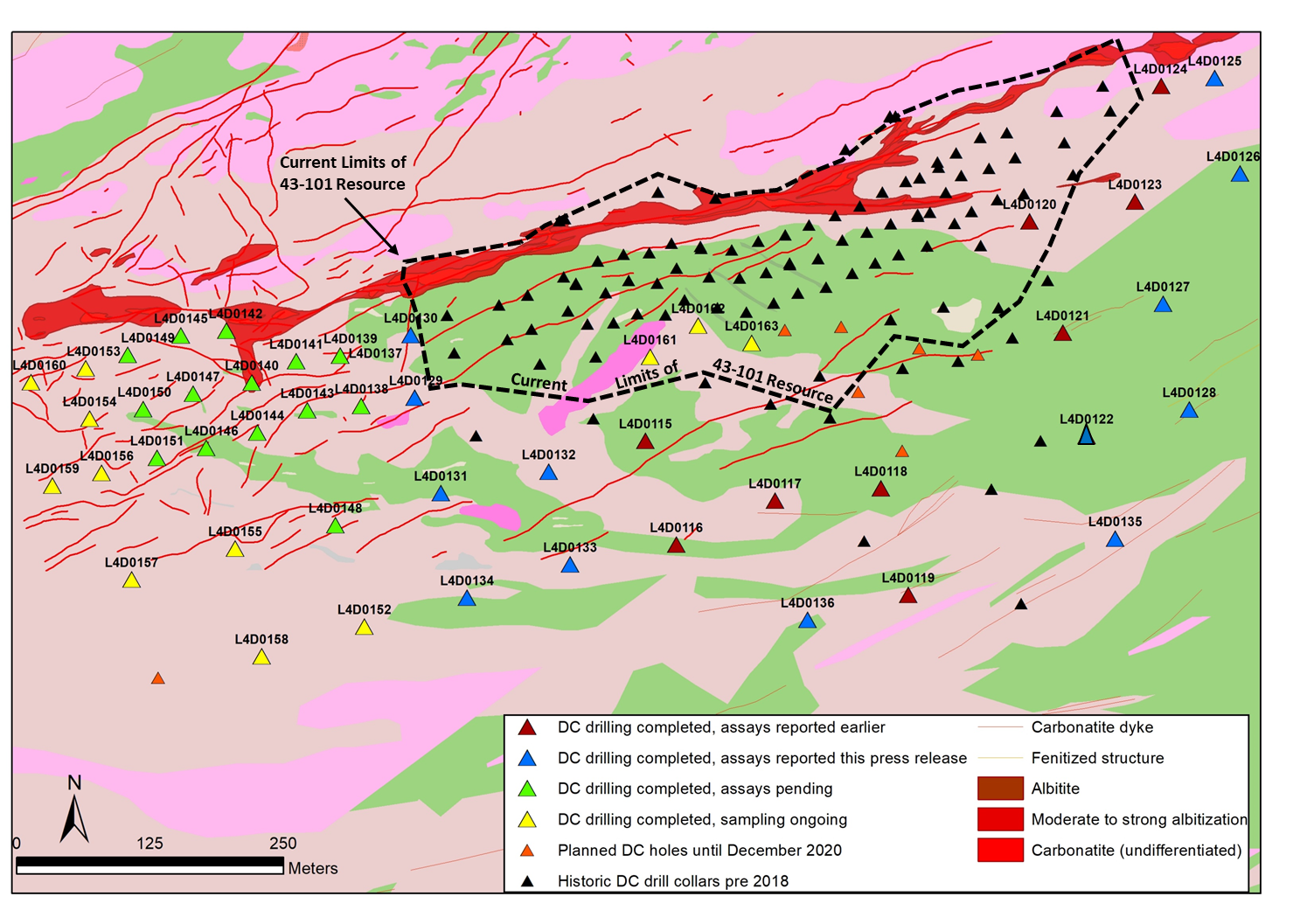
Figure 1 - Area 4 Drill Plan showing historic drill holes (black), holes reported June 18 (red) and holes reporting this press release (blue). Holes drilled but pending analyses (green and yellow) and planned holes (orange). Limits of the current 43-101 resource shown by dashed black line.
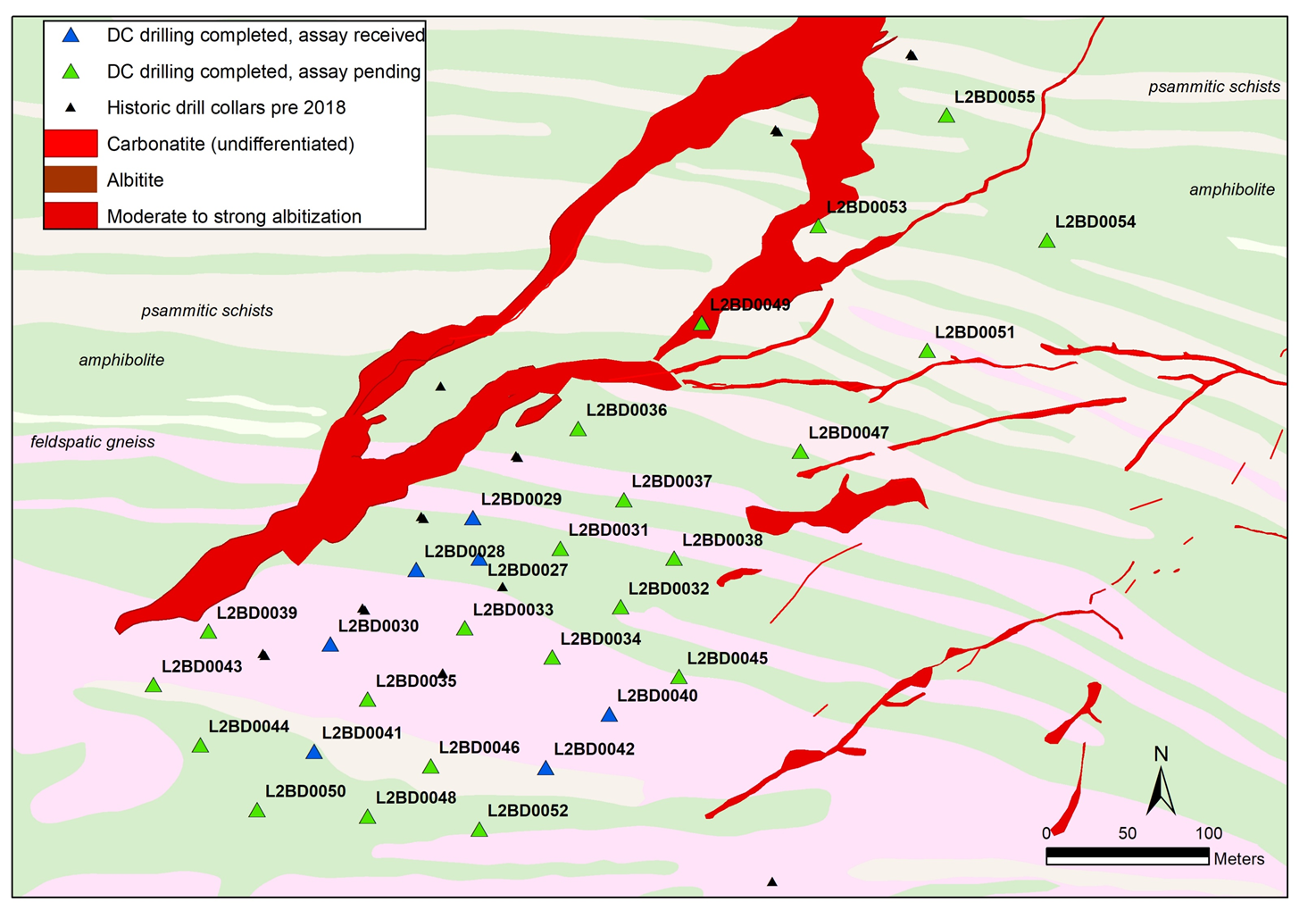
Figure 2 - Area 2B Drill Plan showing historic drill holes (black), holes reporting this press release (blue) and holes drilled but pending analyses (green).
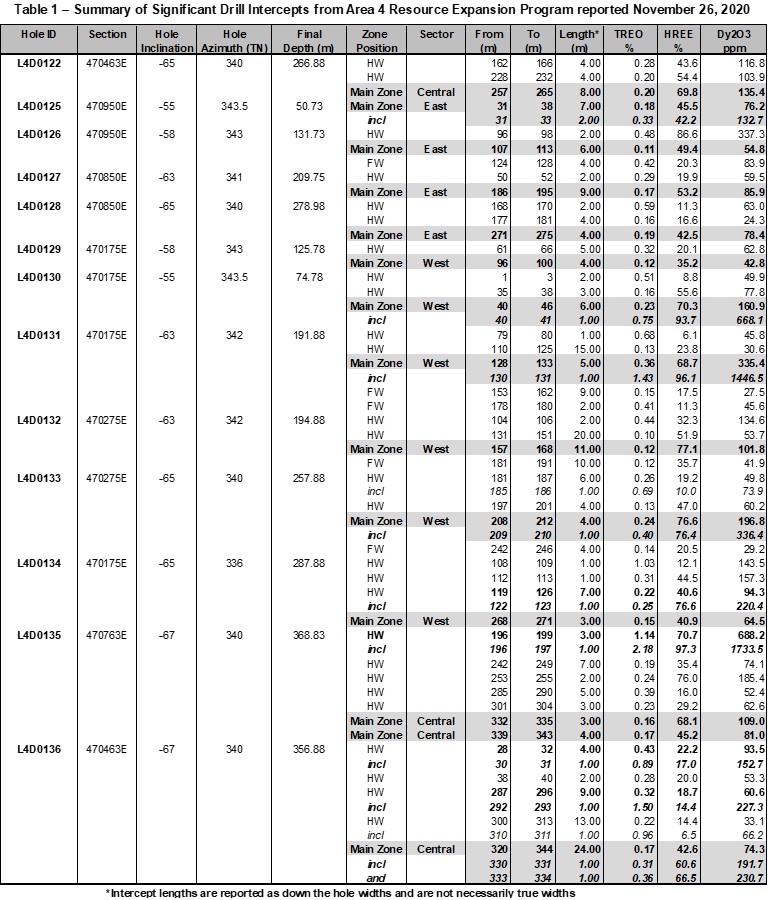
NOTE: "TREO" refers to total rare earth oxides; "HREO" refers to heavy rare earth oxides; "heavy rare earths" as used in all Company presentations comprise europium (Eu), gadolinium (Gd), terbium (Tb), dysprosium (Dy), holmium (Ho), erbium (Er), thulium (Tm), ytterbium (Yb), lutetium (Lu) and yttrium (Y). Light rare earths comprise lanthanum (La), cerium (Ce), praseodymium (Pr), neodymium (Nd) and samarium (Sm). "HREE" refers to heavy rare earth enrichment which is the ratio of HREO:TREO, expressed as a percentage
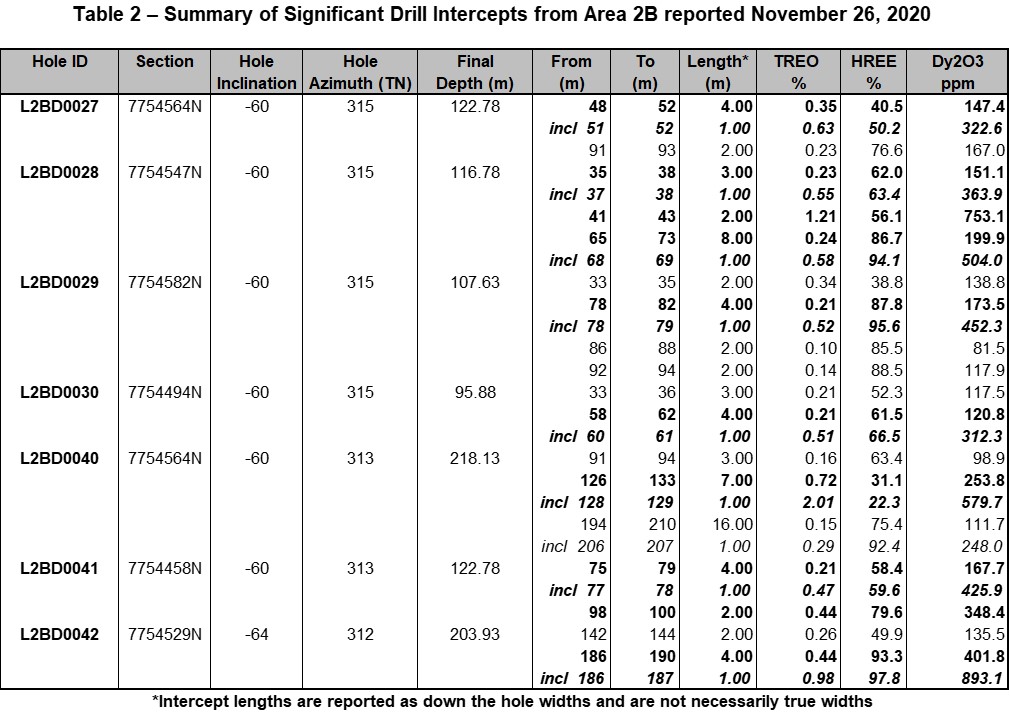
NOTE: "TREO" refers to total rare earth oxides; "HREO" refers to heavy rare earth oxides; "heavy rare earths" as used in all Company presentations comprise europium (Eu), gadolinium (Gd), terbium (Tb), dysprosium (Dy), holmium (Ho), erbium (Er), thulium (Tm), ytterbium (Yb), lutetium (Lu) and yttrium (Y). Light rare earths comprise lanthanum (La), cerium (Ce), praseodymium (Pr), neodymium (Nd) and samarium (Sm). "HREE" refers to heavy rare earth enrichment which is the ratio of HREO:TREO, expressed as a percentage
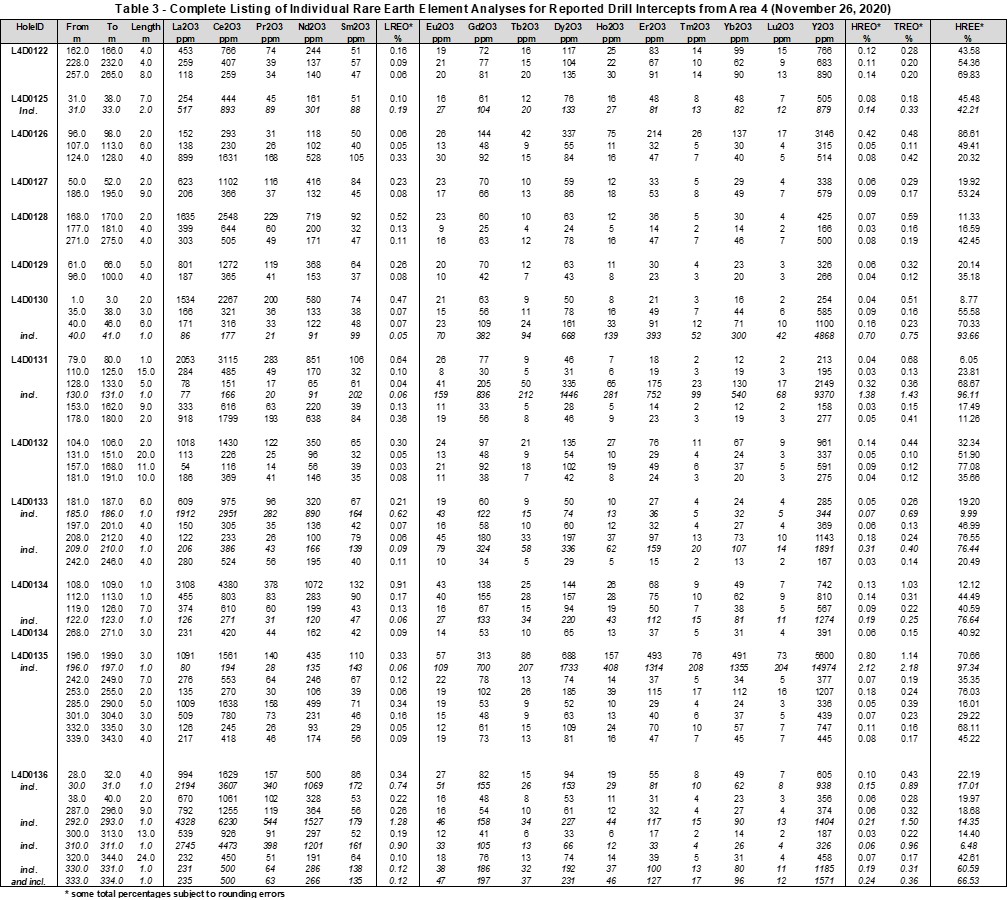
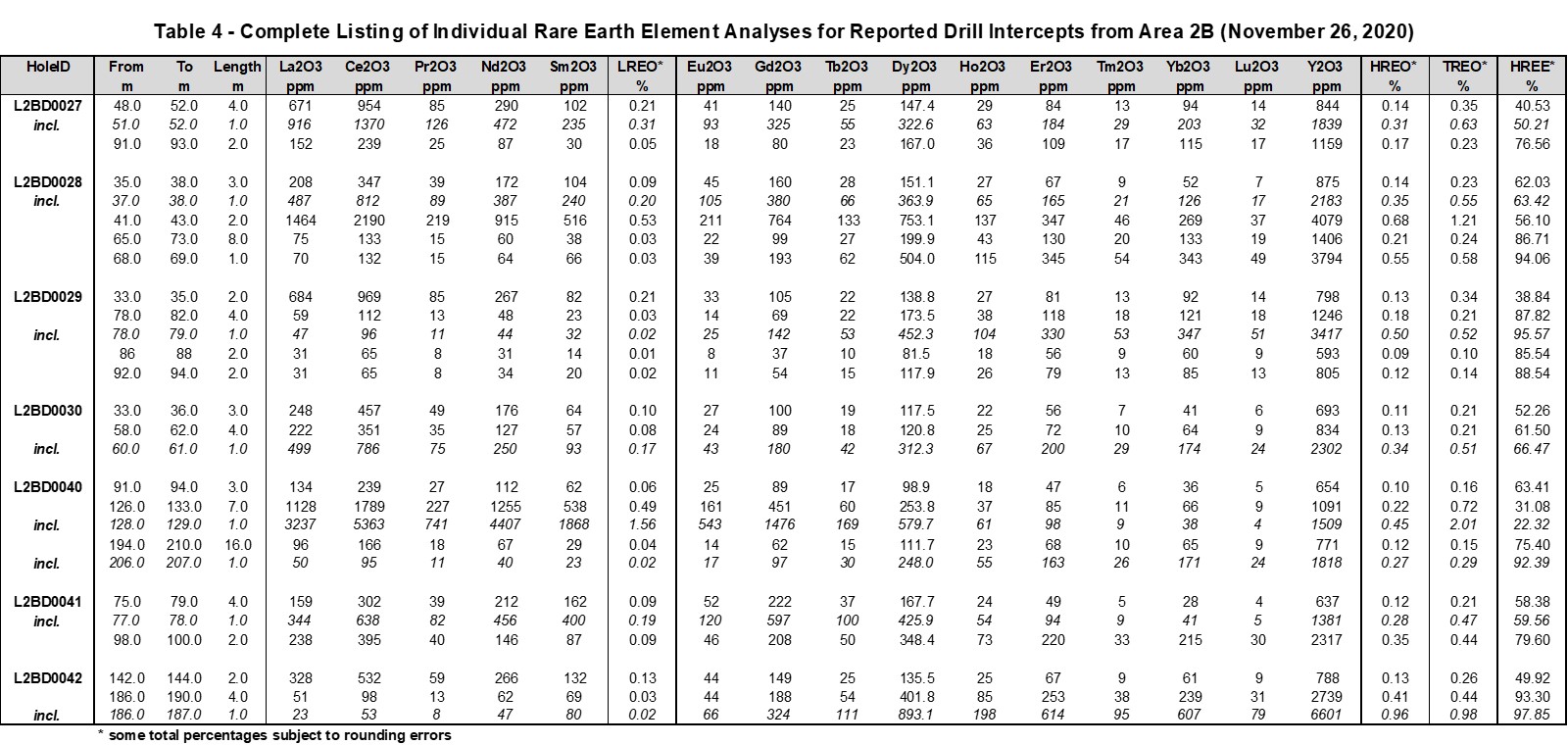
About Namibia Critical Metals Inc.
Namibia Critical Metals Inc. holds a diversified portfolio of exploration and advanced stage projects in the country of Namibia focused on the development of sustainable and ethical sources of metals for the battery, electric vehicle and associated industries. The two advanced stage projects in the portfolio are Lofdal and Epembe. The Company also has significant land positions in areas favourable for gold mineralization.
Heavy Rare Earths: The Lofdal Heavy Rare Earth Project is the Company's most advanced project having completed a Preliminary Economic Assessment in 2014 and full Environmental Impact Assessment in 2017. An application has been made for a mining licence at Lofdal. The project is now in joint venture with Japan Oil, Gas and Metals National Corporation ("JOGMEC") who are funding the current CD$4,100,000 drilling and metallurgical program with the objective of doubling the resource size and optimization of the process flow sheet.
Gold: At the Erongo Gold Project, stratigraphic equivalents to the sediments hosting the recent Osino gold discovery at Twin Hills have been identified but not yet sampled. Soil surveys are progressing over this highly prospective area. The Grootfontein Base Metal and Gold Project which has potential for magmatic copper-nickel mineralization, Mississippi Valley-type zinc-lead-vanadium mineralization and Otjikoto-style gold mineralization. Detailed interpretation of geophysical data and regional geochemical soil sampling surveys are under way.
Tantalum-Niobium: In addition to Lofdal, the Epembe Tantalum-Niobium Project is also at an advanced stage with a well-defined, 10 km long carbonatite dyke that has been delineated by detailed mapping with over 11,000 meters of drilling. Preliminary mineralogical and metallurgical studies including sorting tests (XRT), indicate the potential for significant physical upgrading. Further work will be undertaken to advance the project to a preliminary economic assessment stage.
Copper-Cobalt: The Kunene Copper-Cobalt Project comprises a very large area of favorable stratigraphy ("the DOF") along strike to the west of the Opuwo cobalt-copper-zinc deposit. Secondary copper mineralization over a wide area points to preliminary evidence of a regional-scale hydrothermal system. Exploration targets on EPLs held in the Kunene project comprise direct extensions of the DOF style mineralization to the west, sediment-hosted cobalt and copper, orogenic copper, and stratabound manganese and zinc-lead mineralization.
The common shares of Namibia Critical Metals Inc. trade on the TSX Venture Exchange under the symbol "NMI".
Donald M. Burton, P.Geo. and President of Namibia Critical Metals Inc., is the Company's Qualified Person and has reviewed and approved this press release.
Neither the TSX Venture Exchange nor its Regulation Services Provider (as that term is defined in the policies of the TSX Venture Exchange) accepts responsibility for the adequacy or accuracy of this release.
For more information please contact -
Namibia Critical Metals Inc.
Don Burton, President
Tel: +01 (902) 835-8760
Fax: +01 (902) 835-8761
Email: Info@NamibiaCMI.com
Web site: www.NamibiaCriticalMetals.com
The foregoing information may contain forward-looking information relating to the future performance of Namibia Rare Earths Inc. Forward-looking information, specifically, that concerning future performance, is subject to certain risks and uncertainties, and actual results may differ materially. These risks and uncertainties are detailed from time to time in the Company's filings with the appropriate securities commissions.
1 Preliminary Economic Assessment on the Lofdal Rare Earths Project Namibia dated October 1, 2014 authored by David S. Dodd, B. Sc (Hon) FSAIMM - The MDM Group, South Africa, Patrick J.F. Hannon, M.A.Sc., P.Eng. and William Douglas Roy, M.A.Sc., P.Eng. - MineTech International Limited, Canada, Peter Roy Siegfried, MAusIMM (CP Geology) and Michael R. Hall, B.Sc (Hons), MBA, MAusIMM, Pr.Sci.Nat, MGSSA - The MSA Group, South Africa. The PEA should not be considered to be a pre-feasibility or feasibility study, as the economics and technical viability of the Project has not been demonstrated at this time. The PEA is preliminary in nature and includes Inferred Mineral Resources that are considered too speculative geologically to have the economic considerations applied to them that would enable them to be categorized as Mineral Reserves. Furthermore, there is no certainty that the PEA will be realized.
-30-
SOURCE: Namibia Critical Metals Inc.
View source version on accesswire.com:
https://www.accesswire.com/618520/Namibia-Critical-Metals-Heavy-Rare-Earth-Project--Area-4-Strike-Length-Extended-by-60-and-First-Satellite-Deposit-Successfully-Drilled-for-Planned-Resource-Update

